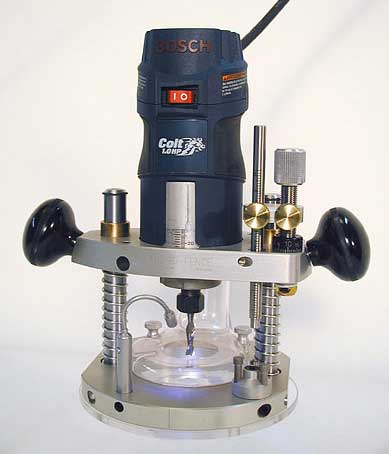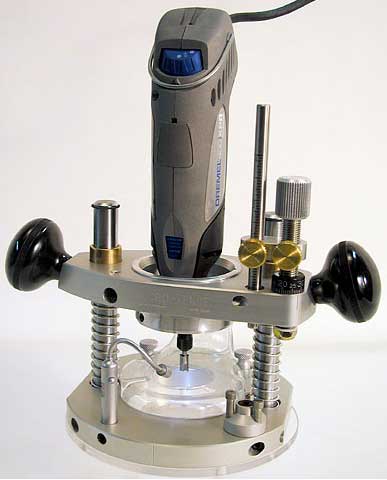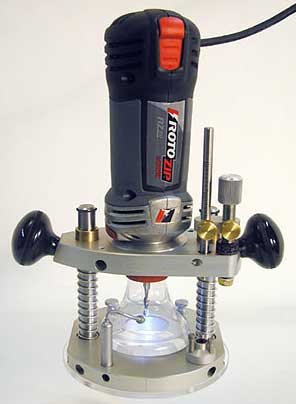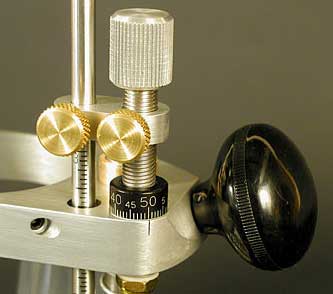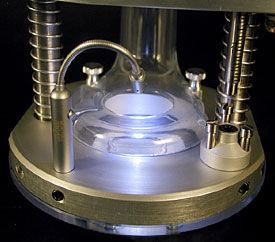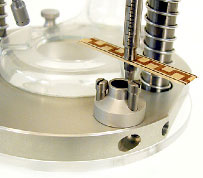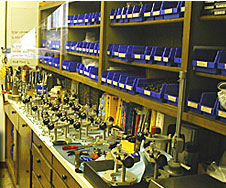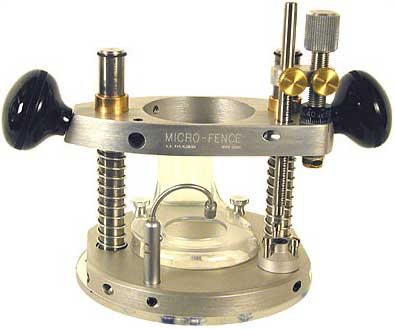
You might recall from our show coverage at last month’s IWF that several tool manufacturers are now building trim routers with plunge capability. That was big news for us at the magazine — it’s a feature that’s almost unheard of within the trim router category. For Rich Wedler, founder of Micro Fence, however, building precision plunge bases for laminate trimmers is just another day at the office.
Micro Fence has been turning out a product called a Portable Three-Axis Mill for four years now, to suit nine or 10 different models of laminate trimmers. And, this plunge base offers a level of accuracy and quality that should give any new plunge trim router a run for its money.
Wedler, a custom woodworker for nearly 45 years, has been offering micrometer-controlled edge guides and circle-cutting jigs for routing since 1993. Over time, he realized an underserved need within routing in general and in his own woodworking in particular to have plunge capability in a much smaller package.
“Back in 2004, I was looking for something that still had the cojones, if you will, but was more manageable than the 35 or so dedicated plunge routers that were available at the time. They all weighed between 12 to 25 lbs. and were far too large for what I wanted in a plunge base machine,” Wedler recalls.
So, he began investigating the features and options he would want to see in a compact plunge router. “For me, I needed a machine with light to medium-duty power, a significant reduction in overall weight and improved visibility, ” Wedler says. Those criteria pointed him in the direction of using laminate trimmers as the power plant and inventing his own base to suit them. Wedler already had a patent on a lead screw micrometer that serves as the adjustment mechanism for other Micro Fence products. Both the Edge Guide and Circle Jig products can be finessed in .001 inch increments with it. The new plunge base would have the same micrometer mechanism to precisely control depth of cut.
Of course, the new Three-Axis Mill didn’t happen overnight. The development process took about two years. Wedler recalls that the first obstacle was how to scale the mechanism and the parts down to keep things compact. He wanted to make the base large enough to accommodate as many different laminate trimmer bodies as possible, but not so large that it would compromise user control. The initial design was proportioned for a Porter-Cable 310 laminate trimmer, then enlarged when Wedler learned about Bosch’s Colt™ Palm Router that was coming to market soon. The base was designed to retrofit to other models using adapter rings that drop inside the top of the unit.
Rich set out to build the Mill from the highest quality components, so the end result would be a good complement to the tool’s micrometer precision. He made the top and bottom of the base from aluminum, outfitted it with a pair of stainless-steel vertical posts and plunge springs and used oil-impregnated bronze bushings to move the router up and down. Initially, the interface between the bushings and posts caused some sticking problems, so Rich improved the posts by hard-chrome plating them and finishing with a multi-step grinding process. It was an expensive and complex machining step to add to the production of the posts, but it ensures silky-smooth plunge action and tight tolerances without “stiction” issues. Chrome finishing also virtually eliminates wear on the bushings over time.
“Another priority of mine was to equip the base with a light source, but I debated about whether it should be powered by the router’s electrical system and fixed permanently in the base or mount independently. If I had gone the first route, a friend of mine pointed out that a customer would have to send in the whole base if the light should fail… Another musician friend of mine actually pointed me toward the gooseneck mini LED light that comes with the base. His roadie had introduced him to it for use on stage to read sheet music. It’s powered independently with replaceable batteries that last for 50 hours, and you can mount the light in four different positions on the base or add more than one light as you like.”
Additionally, the Three-Axis Mill comes with upper and lower dust collection hoods and a vacuum port, along with an acrylic sub-base that accepts standard template guide bushings. Loosening one knob on the base locks or unlocks the plunge feature, and a three-position turret can help set up stopped plunge cuts. It can plunge to a depth of 2-3/4 inches. A single Allen wrench locks the laminate trimmer in place. With a motor installed, the complete unit weighs about seven to eight pounds.
Wedler rolled out the first run of 25 Three-Axis Mills at the 2006 IWF Show, and it received curious response. “I think we got more attention from the other big tool manufacturers than anyone else, but it was satisfying to see that kind of interest. After the show exposure and thanks to a couple of ads that ran in magazines, we sold through the first 25 Three-Axis Mills in a month or two.”
Since then, these precision plunge bases have developed a loyal following, particularly among the Festool Owner’s Group, luthiers, custom flooring installers and other serious hobbyists and professional woodworkers. Wedler says the company sells out on each run of plunge bases in a matter of weeks after their manufacture — and he continues to keep each production run small, at only 25 to 50 bases. Sometimes there’s a waiting list to receive a new base, but Wedler says his customers tend to be “unbelievably patient and loyal. We’re very fortunate for that.”
All of the manufacturing is sourced to local CNC shops around the southern California area where the company is headquartered. Some manufacturing of the smaller parts, plus the final drilling, tapping, grooving, assembly and final packaging happen in house. “I’m finding that I’m more involved in the assembly process than ever with our products. Our Mills are proudly made in the U.S.A., and they are personally assembled by our staff. My hands are on every one of them at some point,” Wedler says.
Still, skeptics occasionally ask Rich why any woodworker needs a plunge base that can be height-adjusted to tenths of the thickness of a human hair. Who really needs that kind of hair-splitting accuracy when we’re working with a material that is constantly expanding and contracting? But Rich considers wood movement to be the very reason why precision is so critical in a plunge base: “There’s that old paradigm that since wood moves, it seems foolish to work to tight tolerances. This movement, however, demands that some tolerance be included… If you know that maple, for instance, is going to swell up to .005 or .0010, you can allow for that clearance. Our Mill allows you to dial in any level of precision you need. Good joinery is based on good measurement, after all. It’s not guesswork. The deeper you get into the craft, the more you realize how important that level of precision is.”
Before ending our interview, I wondered what the “Three Axis” reference actually means. Rich admits that it’s a bit tongue-in-cheek, but it’s a logic rooted in Rich’s commitment to precision: the “Z” axis refers to the base’s vertical plunge travel; the horizontal “X” axis can be precisely fine-tuned if you use the Mill in tandem with the company’s Edge Guide. The “Y” axis? “Well, that one stands for You,” says Rich. “You are finally in complete control.”
